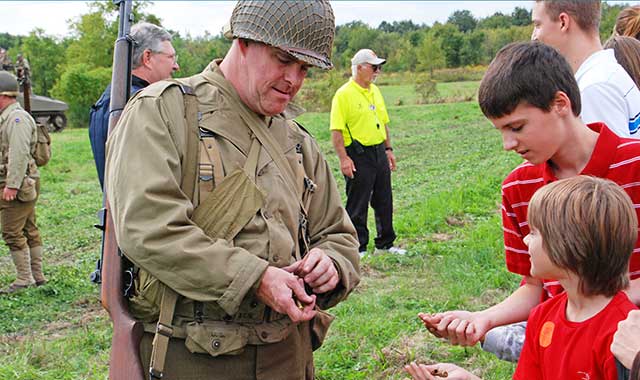In September, Midway Village Museum will be home to World War II Days, the largest such II re-enactment in the Midwest. Learn what to expect at this year’s event, including a day aimed just at youngsters.

The largest World War II re-enactment in the Midwest commences Sept. 23-24 on the 148-acre campus of Midway Village Museum in Rockford. It involves more than 1,300 re-enactors from 40 states and even a few from other countries.
Now in its 21st year, the event will attract 11,000 visitors eager to see booming battles, 60-plus authentic military vehicles and 1,300 costumed re-enactors in character. Themed events occur throughout the day, such as Russian Front or Invasion of France 1940. Thirteen buildings are filled with displays of World War II artifacts and Midway’s 1900-era village is transformed into a 1940s Nazi-occupied French village.
Based on crowd size, it’s obvious that World War II Days has earned a solid fan base. Less well-known, however, is the Education Day that precedes it. It’s an opportunity for teachers, students and homeschoolers to have the campus all to themselves. The museum initiated Education Day in 2003; this year it takes place Sept. 22 from 9:30 a.m. to 2 p.m. Rather than being lost in a crowd of 4,000, the 800 or so students – mostly middle and high school ages – receive the full attention of re-enactors and, remarkably, a World War II veteran guest speaker.
“Our re-enactors are great about interacting with people of all ages and interest levels, whether you’re a total military buff or a total novice,” says Kristen Hoeker, special events coordinator at the museum. “What we like about this day is that the kids are the focus. We tell them, ‘This is your day to get to know about this war and the experiences behind it.’ They don’t have to compete with adults to ask questions.”
There are many hands-on activities, and re-enactors are in full dress rehearsal with their authentic costumes, gear and vehicles.
Students can run an obstacle course, complete with a drill sergeant barking orders, to get a feel for what U.S. Army Basic Training was like. They witness themed skirmishes and skits in the Nazi-occupied French village. In the schoolhouse, they learn about code breaking and try their own hand at it. In the print shop, students make the French identity papers they need to carry at all times, lest they be stopped by a German patrol.
Students can watch radio-controlled World War II airplanes fly and learn how the Army Air Corps morphed into the U.S. Air Force because of World War II. They also experience the home front, touring victory gardens and learning about the many sacrifices and efforts made by civilians to support the war effort.
On Education Day, there are special presentations by museum interpreters, period musical performances and a chance to roam the woods and visit encampments of re-enactor soldiers from many countries. Students also tour the permanent trenches built on the museum grounds for World War
I Days.
“It’s hard for students to visualize the difference between the two world wars,” says Hoeker. “Trench warfare is distinct to World War I, so we teach them about those and some of the other differences.”
This is Hoeker’s third year of coordinating World War II Days. She’s impressed by the respect students have shown both to re-enactors and the World War II veteran guest speakers. This year, that speaker will be Richard Lockhart, who served from 1943 to 1945, was in the Battle of the Bulge and was a prisoner of war.
“It’s one thing to look up something about the war on your iPad,” says Hoeker. “It’s quite a different experience to hear a firsthand account from someone who lived through battles and survived a prison camp. Students will remember these experiences.”
Most teachers do a good job of preparing students for the immersive experience, says Hoeker.
“Still, it’s a shock when you walk into a 1940s-era French village cafe and hear the period music playing and see all the soldiers, vehicles and 1940s civilians. You really do feel you’ve stepped into a different time period.”
The event happens early in the school year, but teachers have told Hoeker they find themselves referring back to student experiences from World War II Days Education Day all year long.
“It’s a kick to see students hanging out eating lunch with a group of ‘soldiers’ sitting around their encampment in the woods,” says Hoeker. “It’s pretty great for everyone involved.”
One of the many good things about this event is the wide array of nations represented by re-enactors portraying soldiers, nurses, French Resistance members and more. Uniformed re-enactors represent the U.S., Great Britain, France, Poland, Ukraine, Russia, Japan, Italy, Germany and many other nations.
“It’s good to be reminded this wasn’t just a war between a few big players. This was truly a world war,” says Hoeker. “You realize this when you see all of the different uniforms and flags, hear the different kinds of music playing, smell the different types of food soldiers are cooking in their camps.”
When doors open to the public on Sept. 23, World War II Days will offer a jam-packed event schedule. Last year, many new items were added in celebration of its 20th anniversary and nearly all will make a comeback. They include period musical performances; a photography exhibit titled “20 Years of Midway Village Museum World War II Event;” a display of World War II radio-controlled model airplanes; and a parachute-making craft.
This year will also bring a 36-panel educational display about the Holocaust, on loan from the Illinois Holocaust Museum. “It’s another element to the overall story of the war,” says Hoeker.
Back by popular demand is a special Friday-night event titled “Behind the Lines with General Patton,” from 5-8 p.m. Participants will enjoy a guided tour of camps and vehicles before the event opens to the public. They’ll hear from re-enactors representing more than a dozen countries involved in the war, tour Gen. Patton’s tent, then sit down to dinner and listen to a special presentation by a Patton living historian. Tickets are $35 for non-members and $30 for members. Pre-registration is required by Sept. 13.
Sadly, fewer World War II veterans attend World War II Days each year. Those who do are treated to free admission, reserved seating and assistance moving about the grounds on golf carts.
“We had 26 attend last year, and everyone goes above and beyond for our veterans,” says Hoeker. “This year we’re offering discounted admission for all veterans and active-duty military personnel.”
Admission to World War II Days is $14 for adults and $8 for children ages 3 to 17. Midway Village Museum members are free. Tickets are sold online, in the museum gift shop and at the gate.
Shuttles run from the parking lots and also within the event to accommodate people who need assistance.
To register your student group for World War II Days Education Day, go online to midwayvillage.com/midway-hands-on-history.html or call Kristen Hoeker, special events coordinator at (815) 397-9112, ext. 104. The registration deadline for Education Day is Sept. 14. Admission to Education Day is $1 for adults and $7 for students. If the $1 seems cheap, it’s by design.
“We like to encourage adult chaperones to attend,” Hoeker explains.
Find a complete schedule of World War II Day events at midwayvillage.com or call (815) 397-9112.




















































